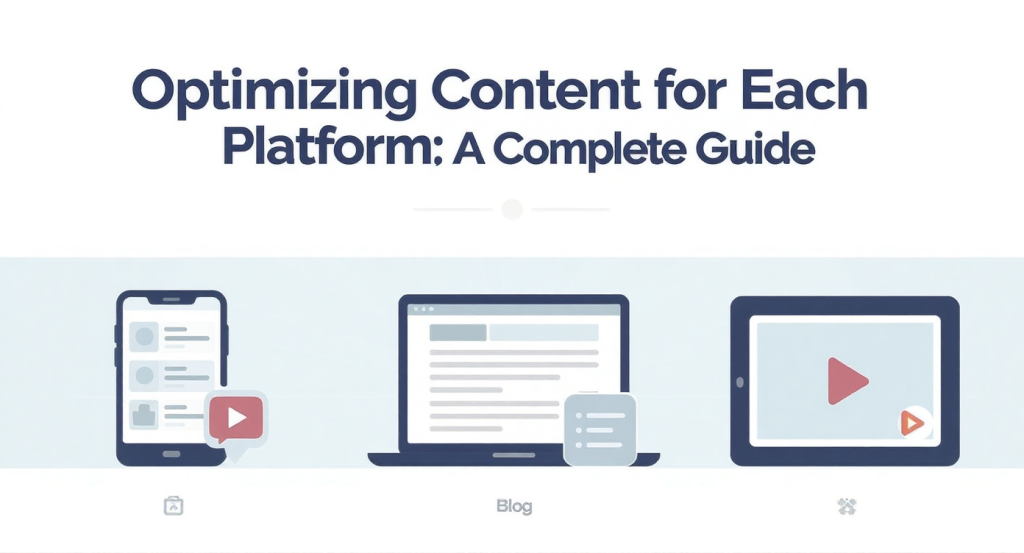In today’s digital marketing landscape, it’s not just about posting content — it’s about posting the right content in the right way on the right platform. Each social media platform has its own audience behavior, technical guidelines, and engagement patterns. What works on Instagram might flop on LinkedIn. What goes viral on TikTok may not even make a dent on Facebook.
So, how do you ensure your content is optimized for every platform?
In this comprehensive guide, we’ll cover:
- Best practices for image size, captions, and post timing
- How to write platform-specific copy
- How to use hashtags, keywords, and social media SEO
- Tools and strategies to streamline your multi-platform content strategy
Let’s dive in.
Best Practices for Posting on Each Platform

Every platform has its own rhythm — its preferred image sizes, audience engagement windows, and even caption lengths. Here’s how to get the basics right.
1. Instagram
Image Size:
- Feed post: 1080 x 1080 px (square)
- Portrait: 1080 x 1350 px (preferred for engagement)
- Stories: 1080 x 1920 px
- Reels: 1080 x 1920 px
Captions:
- First line matters most (only ~125 characters are visible before the “…more”)
- Include a clear CTA
- Emojis and line breaks improve readability
Best Time to Post:
- Tuesday to Thursday between 10 AM – 2 PM
- Avoid late nights or weekend evenings
2. Facebook
Image Size:
- Shared post image: 1200 x 630 px
- Stories: 1080 x 1920 px
- Cover photo: 820 x 312 px
Captions:
- Slightly longer captions work well
- Prioritize storytelling or value delivery
- Include 1-2 strategic hashtags
Best Time to Post:
- Weekdays between 1 PM – 3 PM
- Sundays show lower engagement
3. LinkedIn
Image Size:
- Shared post image: 1200 x 627 px
- Cover photo: 1584 x 396 px
- Carousel/Slides: 1080 x 1080 px
Captions:
- Start with a bold, benefit-driven hook
- Use short paragraphs, emojis sparingly
- End with a question or CTA to drive comments
Best Time to Post:
- Tuesday to Thursday, 8 AM – 11 AM
- Avoid evenings and weekends
4. Twitter (X)
Image Size:
- Shared image: 1200 x 675 px
- Profile header: 1500 x 500 px
Captions:
- Max 280 characters
- Use 1-2 hashtags
- Tag relevant accounts
Best Time to Post:
- Early mornings (7 AM – 9 AM)
- Monday and Thursday are ideal
5. TikTok
Video Size:
- 1080 x 1920 px
- Use vertical format only
Captions:
- 150 characters max
- Hook viewers in the first 3 seconds
- Use trending sounds and hashtags
Best Time to Post:
- Weekdays between 6 AM – 10 AM or 7 PM – 11 PM
- Best engagement on Tuesday and Thursday
6. Pinterest
Image Size:
- Ideal: 1000 x 1500 px (2:3 ratio)
Captions:
- Use keyword-rich descriptions
- Don’t overuse hashtags
- Write in a natural, helpful tone
Best Time to Post:
- Saturdays and Sundays
- Early morning or late evening
Writing Platform-Specific Copy
Content copy is not one-size-fits-all. Each platform has its own voice, user intention, and interaction style. Tailor your copy accordingly.
Instagram Copywriting
- Tone: Friendly, fun, lifestyle-oriented
- Audience Expectation: Inspiration, aesthetics, personality
- Best Practice: Start with a punchy hook, use line breaks, insert emojis for flow
- CTA Ideas: “Double tap if you agree”, “Tag a friend who needs this!”
Facebook Copywriting
- Tone: Informative, conversational
- Audience Expectation: Value-rich, shareable content
- Best Practice: Longer storytelling posts work well. Use paragraphs to break up text.
- CTA Ideas: “Share this if it helped you”, “Tell us your thoughts in the comments”
LinkedIn Copywriting
- Tone: Professional, insightful
- Audience Expectation: Career advice, industry news, B2B content
- Best Practice: Use powerful openers. Add a short value-driven summary before linking out.
- CTA Ideas: “Agree or disagree?”, “What would you add to this?”
Twitter (X) Copywriting
- Tone: Witty, direct, timely
- Audience Expectation: Quick insights, news, opinions
- Best Practice: Use threads for deeper storytelling, and images to stop scrolling
- CTA Ideas: “RT if you needed this”, “Drop your favorite tool 👇”
TikTok Copywriting
- Tone: Casual, humorous, authentic
- Audience Expectation: Relatable content, entertainment, trends
- Best Practice: Hook in the first 3 seconds with on-screen text. Use sound trends.
- CTA Ideas: “Follow for more tips”, “Comment your experience”
Pinterest Copywriting
- Tone: Informative, inspirational
- Audience Expectation: DIY, ideas, guides
- Best Practice: Use keywords in both the title and description. Speak to aspirations.
- CTA Ideas: “Save this for later”, “Try this look for your next event.”
Hashtags, Keywords & SEO for Social Media

Good content needs visibility, and that’s where social media SEO, hashtags, and keywords come in.
Hashtag Strategy by Platform
Instagram:
- Use 10–15 relevant hashtags
- Mix niche and broad tags
- Place in the first comment or end of the caption
Facebook:
- Use 1–2 relevant hashtags
- Use them contextually within the post
LinkedIn:
- Use 3–5 hashtags
- Stick to professional or industry-specific tags
Twitter:
- Use 1–3 trending or topic-based hashtags
- Research hashtags with tools like RiteTag or Hashtagify
TikTok:
- Use 3–5 relevant/trending hashtags
- Combine niche tags (#smallbusinesscheck) with popular tags (#fyp, #trending)
Pinterest:
- Use keywords more than hashtags
- Hashtags have limited reach; focus on searchable titles and descriptions
Keywords & Social Media SEO
Just like web SEO, social media content needs to be searchable. Here’s how to boost discoverability:
- Include keywords in your profile bio – Help people find you in searches
- Use relevant keywords in captions – Especially on LinkedIn, Instagram, and TikTok
- Optimize ALT text – Instagram and Facebook allow you to write image ALT text
- Create saveable and shareable content – Saves are a big ranking factor on Instagram and Pinterest
- Use native search bars – Start typing keywords on each platform to find what users are searching for
Example:
If you’re a fitness coach, using keywords like “home workouts”, “30-day challenge”, and “nutrition tips” across your captions, pins, and videos improves visibility when people search those terms.
Tools to Help You Optimize Across Platforms
Managing multi-platform content can be overwhelming. These tools can help:
- Canva: Create platform-specific graphics and resize in one click
- Later / Buffer / Hootsuite: Schedule content across platforms
- Hashtagify / All Hashtag: Research the best hashtags for any niche
- Grammarly / Hemingway: Edit your platform-specific copy
- Google Trends / Answer the Public: Find keywords for social SEO
Final Thoughts: The Golden Rule of Cross-Platform Optimization
Context is king. Even if you’re sharing the same core idea, how you deliver that content should vary by platform. From image sizes to tone of voice to strategic posting times — aligning with each platform’s culture increases your reach, engagement, and ROI.
Rather than stretching one post across all platforms, reframe it in a way that’s native to each platform’s audience. That’s the difference between just being seen… and being remembered.
